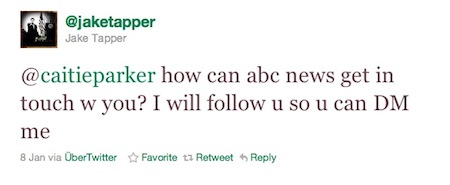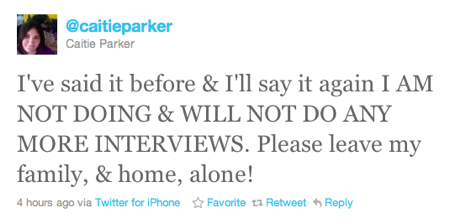
As the story of the shooting of Arizona Congresswoman Gabrielle Giffords continues to unfold, we’re seeing another example of Twitter in motion and the different approaches news organizations take to using social media.
Twitter has proven its usefulness to the media in breaking news as a real-time search tool, an instantaneous publisher, and a source discovery service. It’s that last point that is often of most use — and interest — to reporters on Twitter, finding and talking to people who could be useful in a story. But making that approach can be difficult — if not downright awkward. How does Twitter etiquette work when approaching a potential source, particularly when that approach plays out in the open?
NYC The Blog tracked the media requests of Caitie Parker, a woman who tweeted that the shooting took place near her house and that she was a former classmate of the alleged shooter. And that’s when the stampede for interviews began, with more than 30 interview requests coming in on Twitter from The New York Times, CNN, the Associated Press, and more. (Not to mention a similar number by email and Facebook.) So what were their approaches?
Anthony De Rosa of Reuters seems to be the first person to find Parker and through a series of tweets conducted something in between an interview and standard fact checking. But De Rosa’s discovery seems to be what broke the floodgates on Parker.
Reporters from outlets like the Arizona Daily Star, Arizona Republic, and KTAR radio in Phoenix made a pitch for talking with the local guy, as they tried to compete with the national media parachuting in to cover the story. At least one reporter from the Los Angeles Times tried to play up his local ties, telling Parker he “went to school at UofA.”
Sometimes you have to roll the dice on name recognition and hope it has a little sway. The New York Times wants to talk to you! PBS NewsHour wants to talk to you!
At least a few reporters cut to the chase and asked Parker a question outright, or sought to verify new information about the shooter.
Another approach uses a little empathy — as in, “I know yr overwhelmed,” or “sorry to add to circus.”
ABC News White House correspondent Jake Tapper is known for being savvy when it comes to using social media in his reporting. Tapper apparently decided to cut to the chase and use the parlance of Twitter when reaching out to Parker: “how can abc news get in touch w you? I will follow u so u can DM me”
The end result of all this attention from journalists?
